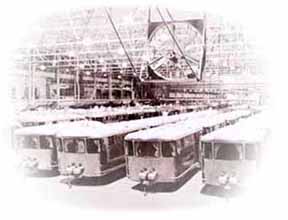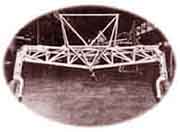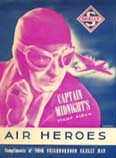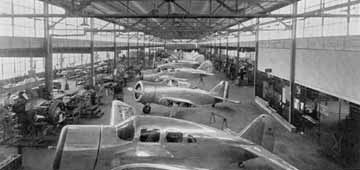 |
|
A
short on the Spartan trailercoach history with production from 1946-1960
|
|
|
 |
|
Rows of Spartan Manors at the Tulsa factory, waiting to hit the road.
|
|
|
|
The following is a compilation of researched information, a written piece from the Tin Can Tourists archives and a phone conversation with Millard O Lumley of Tulsa Oklahoma, an employee of the Spartan Aircraft Company from 1940 - 1961.
The Spartan Aircraft Company was founded in 1928 in Tulsa, Oklahoma. The history of Spartan has its roots in oil. Two years before Oklahoma gained statehood in 1905, an oil gusher named the No.1 Ida Glenn sprung up southeast of Tulsa. This gusher turned out to be a giant oil reserve big enough to establish future companies such as Getty, Gulf, Standard Oil, (now Exxon), Sinclair and Skelly. The teens and twenties were a time of great opportunities. America was moving into the "modern" era. There were many new technologies being introduced and perfected: the automobile, electricity, and airplane flight were among a few. William G Skelly, founder of the Skelly Oil Company came to be known as "Mr. Tulsa". In the 1920's he turned his business into one of the world's largest independent oil companies. Skelly was one of the wealthiest men in the country and was very aware of the "modern" America and emerging technologies. Skelly had a great interest in aeronautics and because of this the Skelly Oil Company sponsored "The Air Adventures of Jimmie Allen" and "Captain Midnight", both series were based around aviation. Skelly's wealth also allowed him to further pursue this interest by founding the Spartan Aircraft Company in 1928. The company was started as an aeronautical college and airplane manufacturer whose early production consisted of open cockpit, canvas bodied biplanes, used for flight training schools, sportsmen fliers, and fixed base operators.
In the late 1930's Spartan was acquired by the Getty Corporation owned by the billionaire and oil tycoon J. Paul Getty. Mr. Getty first visited the plant in 1939. He was very impressed with the quality of inventory, and the management of the company. This combination of good management and quality product allowed the company to prosper. Spartan reinvested its profits in its research and development department allowing them to come up with many technical improvements. One of the most lucrative models to come out of the plant was the "Spartan Executive," an aviation legend and one of the most highly regarded planes of its era. Built to the luxurious tastes of the rich oil "Executives", it rivaled in comfort the most opulent limousines of the day. In performance, it was second to none, cruising at a remarkable 200 miles an hour and with a range of over one thousand miles. The Spartan Company also made a military version of this plane called the "Zeus" both models can be seen in this period factory photo.
These planes were built employing principals of a newly developed technique known as monocoque fuselage design. This means of construction does away with the need for a center framing structure to support the skin. Monocoque construction uses lightweight aluminum ribbing bound with a stressed skin aluminum shell. This form of design gives a great amount of strength to the fuselage with very little weight. The Spartan Executive however did not fully employ this technique opting to use a steel spar sub frame joined with aluminum bulkheads and a stressed aluminum skin. The fuselage did however benefit from this design with a rather spacious cockpit and an overall lighter weight. The sub frame can be seen below. |
 |
|
photo
courtesy of Lorraine Morris
|
|
When the US got involved in W.W.II the patriotic Getty immediately tried to enlist. He went to the Secretary of the Navy Frank Knox, in Washington DC. Secretary Knox told Mr. Getty that his greatest help would be in the Management of his Company Spartan Aircraft to help with the production of Airplanes and parts for the War. Getty came to Spartan in February of 1942 and fully threw himself into the operation of running a airplane manufacturing plant. Spartan received a contract to build Navy trainers the Spartan NP-1 The Fuselage was welded chrome moly steel tubing, and fabric covered. This was there only wartime commission for a complete plane although they made many components, which were used on other war contract planes such as Gruman, Lockhead and Curtiss. At the end of the W.W.II the Spartan factory was beefed up due to wartime production. Getty had to decide where he was going to take the company next. The company needed a product that could marketed to a large audience. His engineers were busy with several exciting projects. A 5-passenger airplane prototype was completed and flown, its performance surpassed expectations and would be the best plane the company had ever built. In addition to this new plane they were also working on a new type automobile and a radically designed travel trailer. Due to the war the competition in airplane manufacturing had risen greatly. Along with the fierce competition in new aircraft, top management figured the cost in dollars and length of time before their new plane design could be in production and producing supply for inventory would be to great an expense. As far as automobile manufacturing went the cost of retooling would be out of the question and this was too much of a departure from what they new best. With the great need for housing after the war Getty determined that trailer manufacturing would be the way to go. The first prototype was made in the summer of 1945 using aircraft design similar to the Spartan Executive without much concern for other trailer design of the time. More on the history of the prototype. They were out to produce the best product on the market. Using building techniques and designs that they had mastered in the aircraft building industry. By mid 1945 the pilot model shown below had been completely road tested and a small production run of 100 was scheduled. G.R. Schutes, a designer of national reputation, had been hired to give the trailers a modern look incorporating many deco design elements. |
 |
|
photo
courtesy of James Edwards
|
|
|
True to there intent Spartan spared no expense on these trailers. Manufactured to the highest quality and sleekest design employing the monocoque building technique used in airplane manufacturing, they were truly the "Cadillac" of trailers. When we compare the price of a brand new home in Levittown for under $8000 including the land the 25 foot Spartan Manor at close to $4000 was rather expensive. The first models rolling off the production line in the mid 40's to early 50's could be considered true travel trailers in every since with the largest reaching around 35 feet long. As the interstate highway system began to come into existence things would change. The company started making much larger trailers, or homes as Spartan preferred to call them. They were furnished in the latest of styles from couches to window coverings. The 50's saw a great rise in the number of competing trailer manufacturing companies. Most offering models priced much below that of Spartan. In 1958, to stay competitive, Spartan introduced 2 new lines of trailers. The "Sparcraft" an all aluminum and riveted trailer constructed with less appealing styling than the Spartan ie: no compound curves lower grade aluminum and more conservative interiors of lessor quality. Their super economy line the "Sparlane" was a basic boxy affordable mobile home. 1962 marked the final year of production. At this time Spartan had a very extensive line of trailers with 19 models. The largest reaching 10 feet wide by 57 feet long. A fleet of 29 2-ton Internationals was used to deliver these large homes. Among this line up Spartan introduced the "Crescendo" and the "Carousel" two trailers with ultra modern 50's styling and never before seen curving floorplans. Sadly this would be the last of the Spartans produced. |
 |
| In 1962 the plant closed and the company went into the insurance and financial business, under the name of the Minnehoma Insurance Co., After closing its plant, Spartan sold its name to the Spartan School of Aeronautics, which continues today. |
|
|


